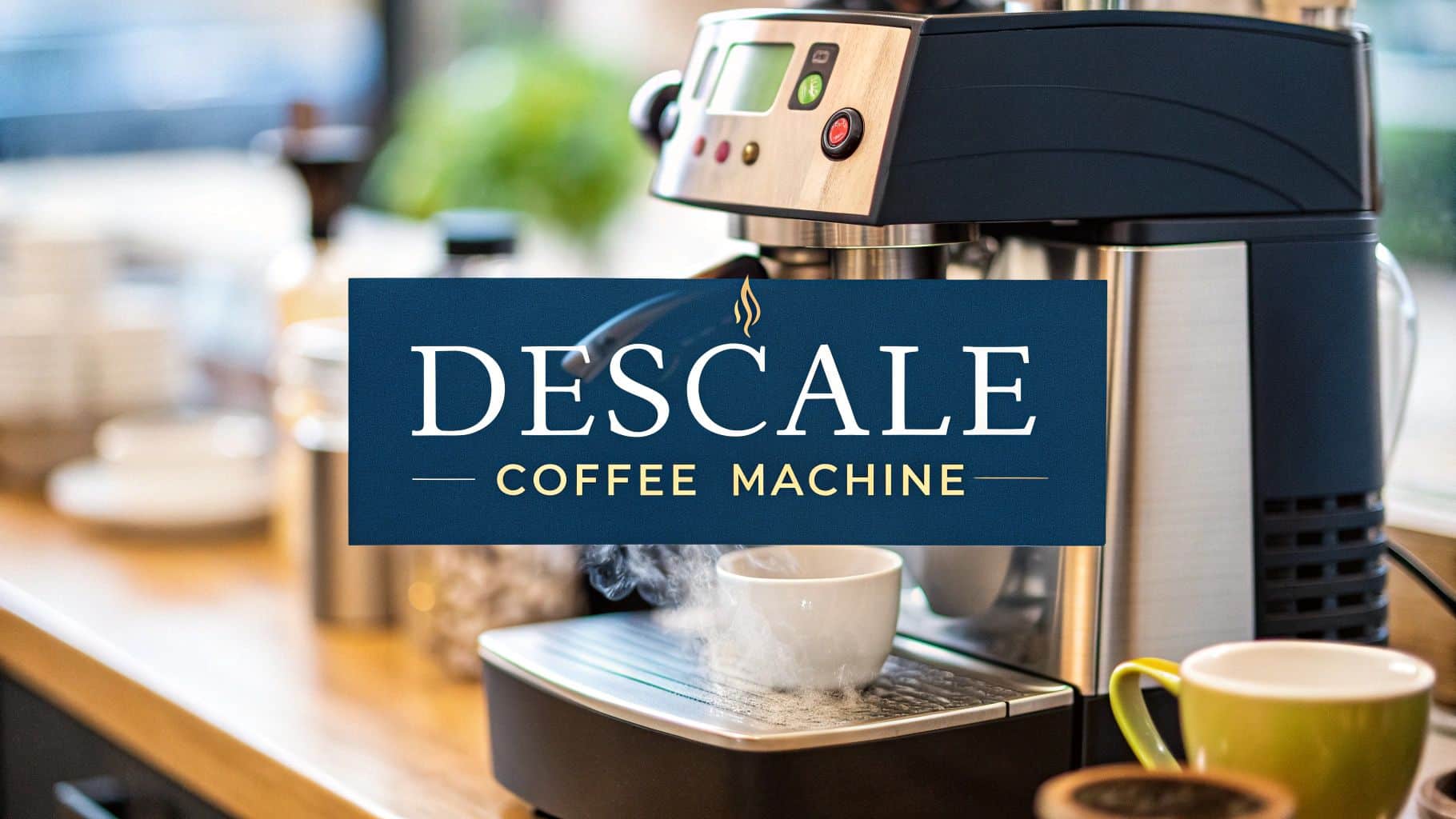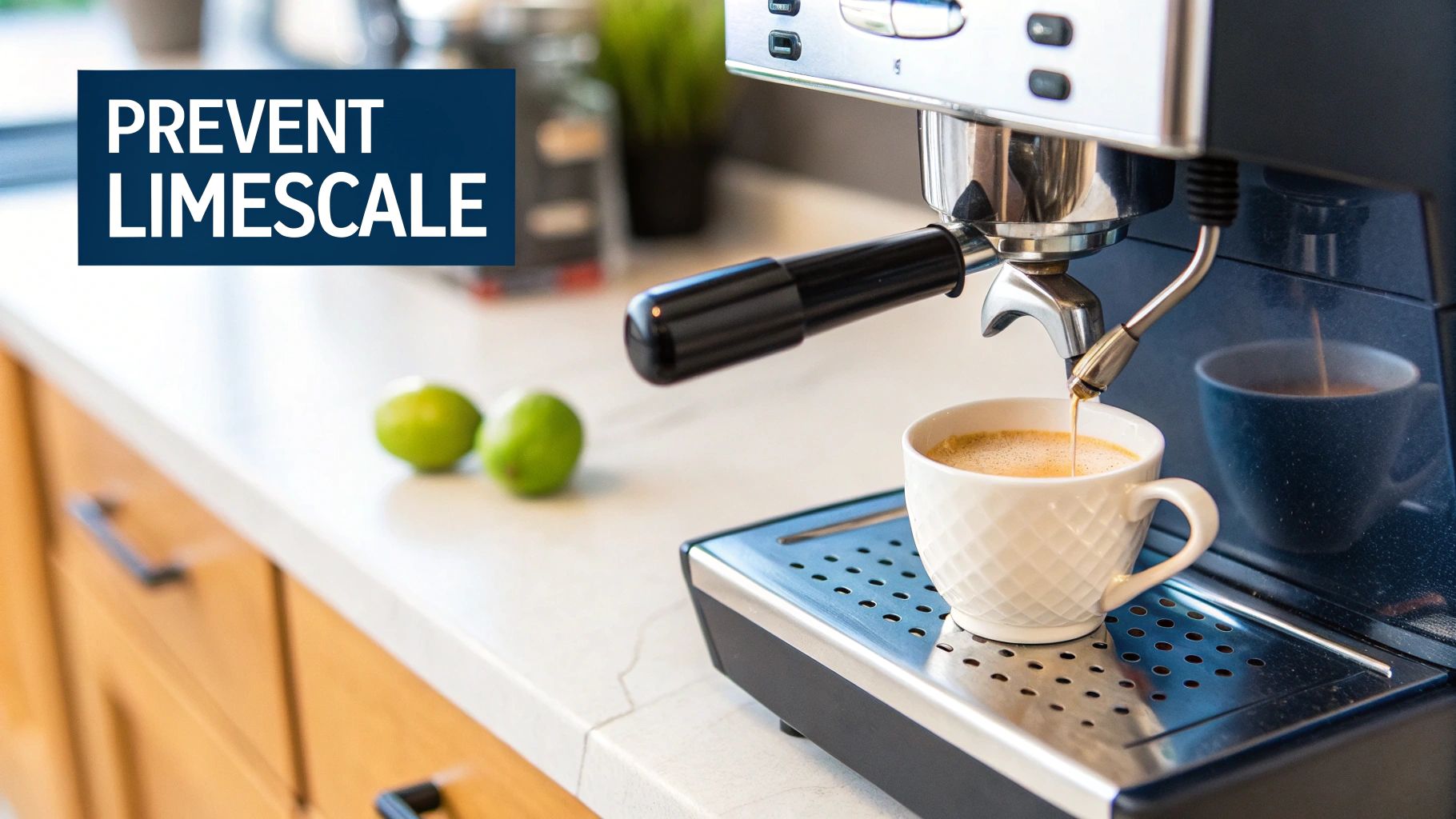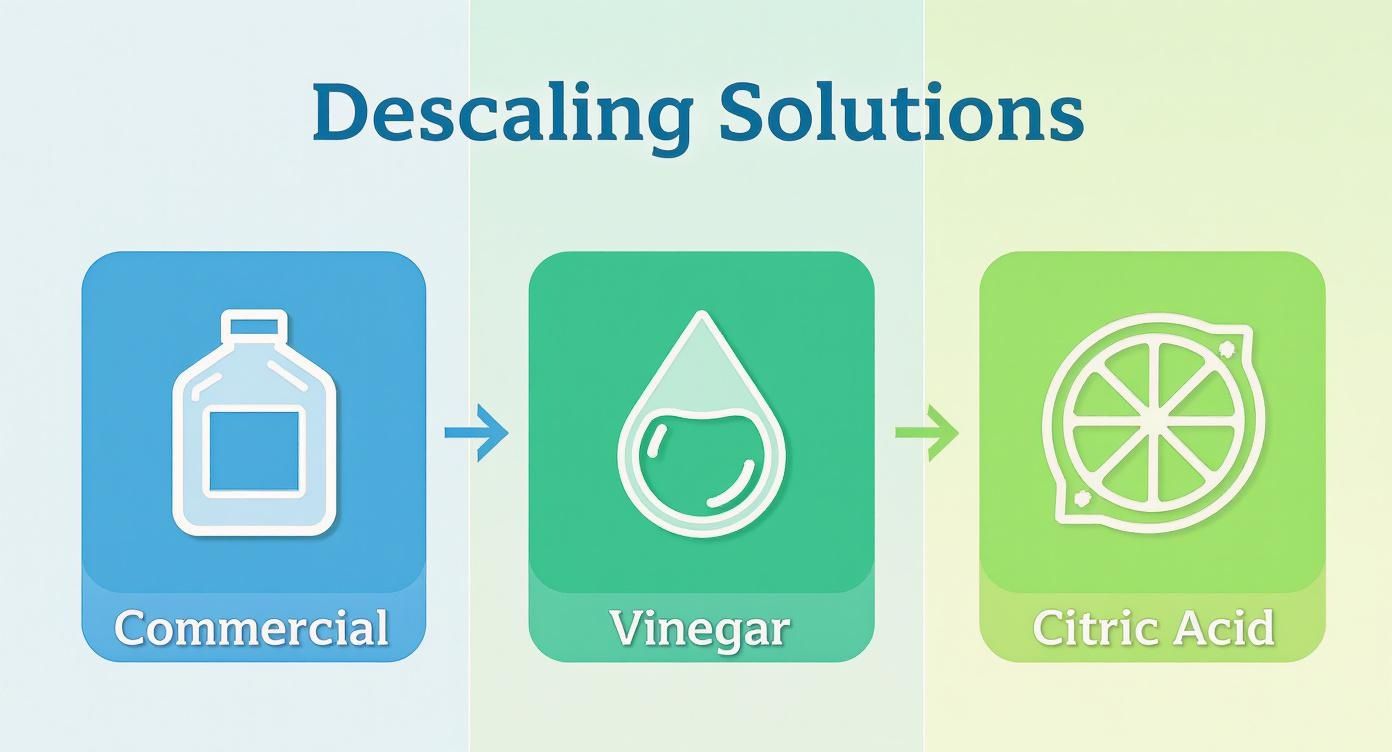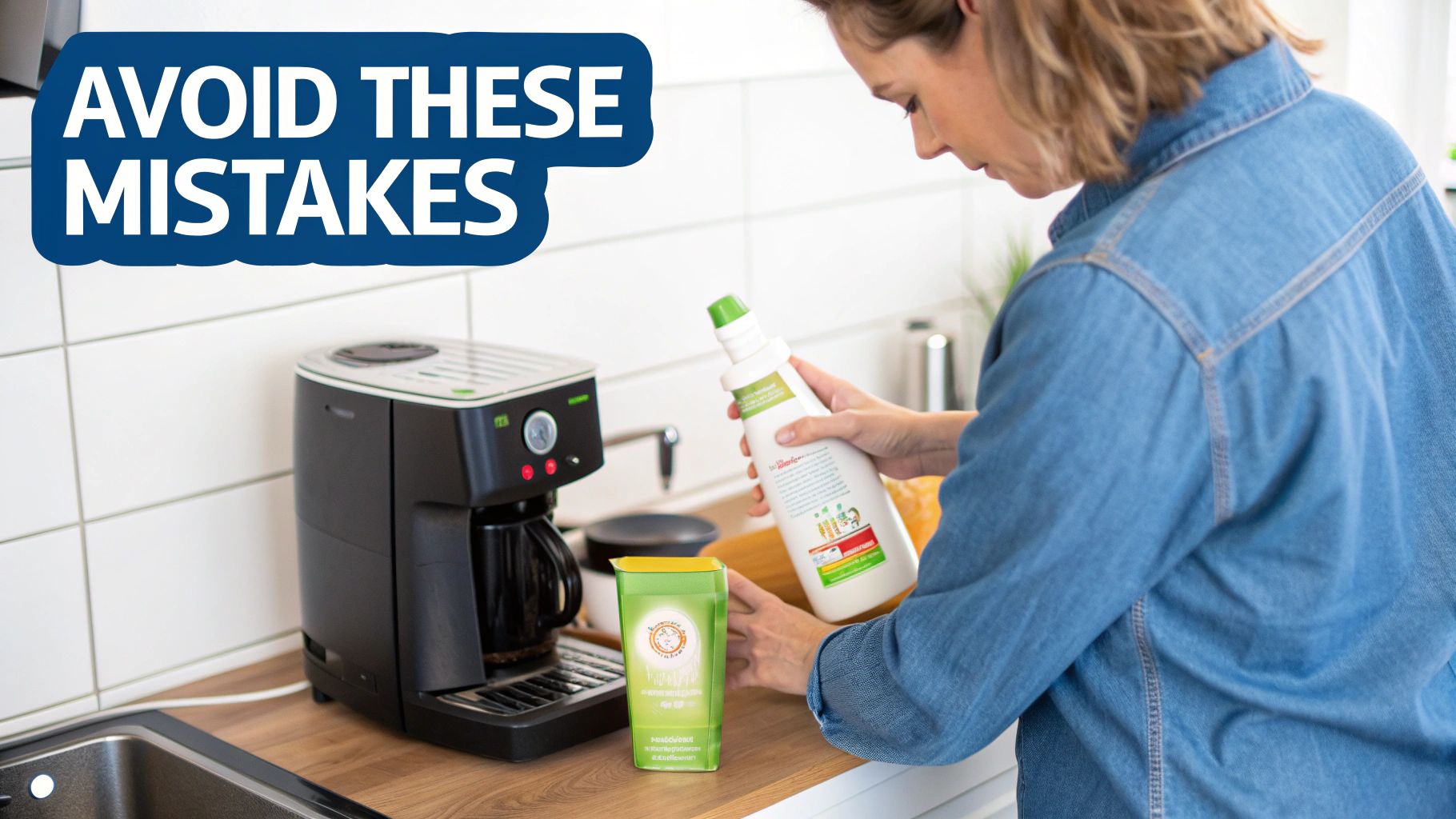How to descale coffee machine: UK guide

Descaling a coffee machine is a pretty straightforward process. Essentially, you run a special descaling solution (or a homemade mix like citric acid) through the machine's water system. This simple action dissolves and flushes out the mineral buildup, known as limescale, which drastically improves your machine's performance and, most importantly, the flavour of your coffee. For any coffee enthusiast, think of it as a crucial bit of maintenance, not just a cleaning chore.
Why Descaling Your Coffee Machine Matters
We've all been there – that first sip of morning coffee is supposed to be perfect, but over time, a hidden enemy starts to sabotage it: limescale. This chalky deposit, mostly made up of calcium carbonate, comes from the minerals floating around in our tap water, especially in hard water areas.
When water heats up inside your machine, these minerals get left behind. They form a stubborn crust on the heating element, pipes, and other internal bits. This buildup acts like an insulator, forcing your machine to work much harder and less efficiently to hit the right brewing temperature.
The Impact on Your Coffee and Machine
The consequences of ignoring limescale are twofold, and neither is good. It messes with both your coffee's quality and your machine's long-term health.
- Flavour Sabotage: A machine that isn't hot enough can't properly extract all those complex, wonderful flavours from your coffee grounds. The result? A brew that often tastes weak, disappointingly sour, or even bitter.
- Reduced Lifespan: The extra strain on the heating element can cause it to fail prematurely. That means you're looking at costly repairs or, even worse, having to buy a whole new machine.
- Poor Performance: You might notice your coffee just isn't as hot as it used to be. Or maybe the water flow has become slow and inconsistent. Both are classic signs of limescale buildup, and both lead to a poorly brewed cup.
Descaling isn't just about cleaning; it's the secret to preserving that perfect coffee experience, day in and day out. It guarantees you get consistent temperature, optimal flavour extraction, and a much longer life for your beloved coffee maker.
Think about it this way: in many parts of the UK where hard water is the norm, descaling is simply not optional. We've seen commercial coffee machines in London that need this maintenance every 2-4 weeks just to combat the mineral buildup that ruins taste and performance.
Ultimately, if you're serious about your coffee and want to know how to make perfect espresso at home, consistent descaling is absolutely key.
Choosing the Right Descaling Solution
Before you even think about starting the descaling process, you’ve got to pick your weapon of choice. This decision is more important than you might think; it affects not just how well the job gets done, but the long-term health of your machine's guts.
Essentially, you're choosing between two main camps: commercial descalers cooked up in a lab specifically for the task, and common household items like white vinegar or citric acid. Each has its place, and it’s worth knowing the upsides and downsides before you commit.
Commercial products are engineered to dissolve that stubborn limescale fast without being harsh on sensitive parts like rubber seals or aluminium heating elements. On the flip side, natural solutions are usually cheaper and probably already in your cupboard.
Commercial Descalers vs DIY Options
Let's be blunt: a commercial descaler is almost always your safest bet. It's been designed by people who know exactly what materials are inside your coffee machine. These solutions are typically non-corrosive and rinse away clean, meaning no weird aftertaste ruining your next flat white. Yes, they cost a bit more, but that’s a small price for peace of mind, especially if you've invested in a pricey bean-to-cup machine.
Vinegar is the go-to DIY option for many, thanks to its powerful acidity and rock-bottom price. But—and it's a big but—that pungent smell can hang around for ages. More importantly, the acetic acid can be too aggressive for some machines, potentially wrecking rubber gaskets and seals over time.
Citric acid is a much gentler, odour-free alternative that’s still a beast when it comes to breaking down mineral deposits. For more serious or persistent scale issues, you might even look into professional scale management solutions like Scalenet for a more robust approach.
Choosing the right solution is a balance between cost, convenience, and protecting your machine. While vinegar might get you out of a bind with some models, a dedicated commercial descaler or citric acid is usually the smarter, safer choice for keeping your machine happy and your coffee tasting pure.
There's an environmental angle here, too. Here in the UK, we're seeing a big push for eco-friendly cleaning products, and descaler manufacturers are catching on. More and more biodegradable and sustainable options are hitting the shelves, which is great news for both your coffee machine and the planet.
To make things a bit clearer, here’s a quick rundown to help you pick the best descaling method for your machine and your priorities.
Comparing Descaling Solutions: Vinegar vs Citric Acid vs Commercial
This table gives you a quick-glance comparison to help you choose the best descaling method for your needs, covering everything from how well it works to how kind it is to your machine and the environment.
| Solution Type | Effectiveness | Machine Safety | Cost | Eco-Friendly? |
|---|---|---|---|---|
| White Vinegar | Good, but can be slow | Risky. Can damage rubber seals and some metals over time. Lingering odour. | Very Low | Yes, biodegradable |
| Citric Acid | Very good, often faster than vinegar | Generally safe for most machines. Odourless. | Low | Yes, biodegradable |
| Commercial | Excellent, formulated for fast and complete removal | Safest option. pH-balanced to protect internal parts. No aftertaste. | Moderate to High | Varies, but many eco-friendly options are available |
Ultimately, the choice comes down to what you value most. For an expensive machine or guaranteed results without any risk, a purpose-built commercial product is the way to go. For a budget-friendly and effective clean, citric acid is a fantastic runner-up. Just be cautious with vinegar—it might do more harm than good in the long run.
The Descaling Process for Your Coffee Machine
Right, you’ve picked your descaling solution, so now it’s time to get to work. While the exact steps might change a little depending on your machine, the basic dance is always the same: prepare, descale, and rinse. The whole point is to get that descaler running through the machine's veins to break down limescale, and then flush every last trace of it out.
This guide gives you straightforward, no-nonsense instructions for the most common coffee machines you'll find in UK homes. We’ll walk through drip filter machines, pod systems like Nespresso or Tassimo, and the more complex bean-to-cup models. Follow these steps, and you’ll get the job done right, without damaging your machine or leaving a nasty chemical taste in your next brew.
Before you start on any machine, give it a quick clear-out. Get rid of any old coffee grounds or pods, tip out the water in the reservoir, and remove the drip tray. Starting with a clean slate means no stray coffee oils can get in the way of the descaler.
Drip Filter and Pod Machine Descaling
Good news – for most drip and pod machines, this is refreshingly simple. Once you’ve emptied everything, you’ll mix your chosen descaler with water right in the water tank. Just follow the ratio on the product’s packaging or your own DIY recipe.
Stick a big jug under the spout to catch the solution as it runs through. If it’s a pod machine, double-check there’s no pod left inside. Then, just kick off the brew cycle and let about half of the solution run through.
Here’s a pro-tip that makes all the difference: pause the cycle halfway through. Let that hot solution sit inside the machine's pipes and heating element for about 20-30 minutes. This gives the acid time to properly get to work on any stubborn mineral buildup.
After that wait, finish the brew cycle and let the rest of the solution drain into the jug. Chuck the used solution away, give the water tank a good rinse with fresh water, and get ready for the final, and most crucial, stage.
The infographic below breaks down the pros and cons of the most common descaling solutions you might be using.
It’s a handy visual guide to the trade-offs between cost, effectiveness, and how gentle each option is on your machine, helping you feel confident you've made the right call.
Bean-to-Cup Espresso Machine Guide
Most modern bean-to-cup machines are smart enough to handle descaling themselves. You’ll usually get an alert on the display when it’s time, and from there, it’s just a matter of following the on-screen instructions.
Typically, the machine will guide you through a few key steps:
- Filling the Tank: You’ll be prompted to add the descaling solution and water to the reservoir, following the manufacturer’s specific instructions.
- Starting the Cycle: Next, you’ll activate the descaling mode from the menu. The machine then takes over, running the solution through its entire internal system, including the coffee spout and any hot water or steam wands.
- Rinsing Thoroughly: Once the main cycle finishes, the machine will tell you to rinse the water tank and fill it with fresh water. It will then run one or more automatic rinsing cycles to flush out any leftover descaler.
Whatever you do, don't skip the rinses! This step is absolutely vital for making sure your next coffee tastes clean and pure. Getting the rinse right is just as important as the descaling itself if you want to know how to make a great espresso.
How Often to Descale in UK Hard Water Areas
Figuring out the perfect descaling schedule isn't a one-size-fits-all deal. Honestly, it comes down to your postcode. The real villain here is hard water—tap water that's full of minerals like calcium and magnesium, just waiting to build up inside your machine.
Across the UK, water hardness can be dramatically different from one town to the next. If you're in the South East or London, you're sitting on chalk and limestone bedrock, which means you have some of the hardest water in the country. Limescale will build up in your machine much, much faster.
On the flip side, if you live in Scotland or parts of Wales, you're in luck. The water is much softer, so mineral buildup is a far slower process. The difference is pretty stark and has a direct impact on how often you'll need to descale.
Creating Your Personalised Descaling Schedule
So, how do you know what you’re dealing with? It's easier than you think. Most UK water suppliers have a free postcode checker right on their website. A quick search will tell you just how hard your water is, so you can build a routine that keeps your machine running like new.
A good maintenance habit stops problems before they even start, making sure every cup of coffee is as fantastic as the last. For a deeper dive into perfecting your brew, our guide on how to brew coffee is packed with tips to help you master the fundamentals.
Here are a few realistic guidelines based on where you are in the UK:
- Very Hard Water (e.g., London, Kent, Sussex): You're on the front lines of the limescale battle. To keep your machine happy, you should really be descaling it once a month.
- Hard Water (e.g., The Midlands, East Anglia): Limescale is still a formidable opponent here. A descaling cycle every two months should keep things in check.
- Soft Water (e.g., Scotland, North West England): You’ve got a real advantage. Descaling every three to four months is a perfectly sensible approach.
No matter your water type, if your machine has a descaling alert, don't ignore it. Those sensors are specifically calibrated to detect buildup and give you a foolproof signal that it’s time for a clean. Sticking to a proactive schedule is simply the best way to give your coffee machine a long and healthy life.
Common Descaling Mistakes to Avoid
We've all been there. You follow the steps, but something still goes wrong. Learning from others' mistakes is a lot less expensive (and frustrating) than making them yourself, especially when it comes to your beloved coffee machine.
One of the most common slip-ups I see is getting the descaler concentration wrong. It’s easy to think "more is better," but pouring in undiluted vinegar is far too harsh. Over time, that potent acid can eat away at the delicate rubber seals and internal metal bits of your machine. Always follow the packet instructions or a trusted recipe to the letter.
Another classic pitfall is not rinsing properly. After you've run the descaling solution through, it's absolutely vital to flush the entire system with fresh water. If you skimp on this part, you're guaranteed a nasty, chemical aftertaste in your next few coffees. Trust me, it’s not a flavour you want.
The Rush to Brew and Other Errors
It’s so tempting to get a brew on the moment the descaling cycle finishes, but hold fire. A proper rinse isn't just one quick flush. You really need to run at least two full tanks of plain water through the machine to be certain every last trace of the descaling agent is gone.
Here are a few other common missteps I've seen over the years:
- Forgetting the fiddly bits: Don't just focus on the inside. All the removable parts, like the drip tray, water tank, and portafilter, need a good clean separately.
- Using baking soda: A lot of people mix this up. Baking soda is a fantastic cleaner, but it won’t touch limescale. It actually neutralises acids, so it does the opposite of what a descaler needs to do.
- Putting it off: The biggest mistake of all? Simply not descaling often enough. Waiting until your machine is gurgling and struggling allows limescale to build up and cause real, permanent damage.
The goal of descaling isn't just about getting rid of limescale. It's about doing it safely and rinsing thoroughly to protect your machine's longevity and, most importantly, the taste of your coffee.
It’s no surprise that the global market for coffee machine descalers is booming, currently valued at around $310.8 million and set to keep growing. It shows just how many of us are realising that proper maintenance is key. You can learn more about the market forces behind this trend in this detailed industry report.
Your Descaling Questions Answered
Even with the best instructions, you're bound to have a question or two. Here are some quick, practical answers to the most common queries we get about descaling, so you can feel confident you’re doing it right.
Is Using Filtered Water a Substitute for Descaling?
No, but it’s a brilliant move that will make your life a lot easier! Using filtered water drastically reduces the minerals floating around, which means limescale builds up much, much slower.
However, even the best filters don't catch 100% of the minerals. So, while you won’t have to descale as often—maybe just every 6-12 months instead of every few weeks—you’ll still need to do it eventually. Think of it as a simple habit that will massively extend your machine's lifespan.
What if I See White Flakes After Descaling?
Don't panic! Those little white bits are almost certainly chunks of limescale that got knocked loose but didn't quite make it out during the rinse. It’s a really common sight, especially if it’s been a while since the last clean.
The fix is simple: just run more plain water through your machine. I always recommend at least two to three full rinsing cycles to make sure every last particle is flushed away before you brew your next coffee.
Remember, a thorough rinse is just as important as the descaling cycle itself. Rushing this final step is often the cause of lingering tastes or leftover particles in your first cup post-clean.
Of course, a clean machine is only one part of the puzzle for a perfect brew. Understanding how grind size affects your coffee can be a game-changer, which you can dive into with our comprehensive coffee grind size guide. And for broader cleaning advice, these general kitchen appliance cleaning tips offer some great pointers.
At Seven Sisters Coffee Co, we believe a well-maintained machine is the key to an exceptional brew. Explore our range of high-quality, sustainably sourced coffee beans to truly taste the difference. https://sevensisterscoffee.co.uk




